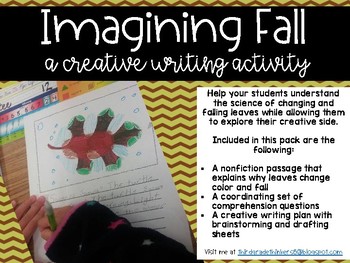I love fall and I love that as a teacher, I get to share my enthusiasm with my students.
Kids are naturally curious and there is so much to wonder and think about as we look around at the changes that emerge with the onset of this new season.
There are so many questions that kids want and need answers to:
Why does it get colder in fall?
What causes the trees to change color and drop from trees?
How do animals survive through the long winter months ahead?
Classrooms should be places where kids are encouraged to think, wonder and question.
Then it is our duty to help equip and empowered students so they can investigate and make discoveries.
I love using literature as springboards to get kids to think, to spark their curiosity.
Here is a fun one that I've used in the past to get my children to think about how leaves change color.

I use this book as a read aloud that is focused on the changes that occur in nature at this time of year. In this book, Fletcher becomes concerned about a tree that is losing leaves. He is worried that the tree is sick. Fletcher tries to help the tree keep its leaves, until at the end of the story, Fletcher wakes up to see the tree glistening and covered with frost. He appreciates the beauty of the tree, even without its leaves.
From there, my students will read a short nonfiction passage that explains the science of the changing colors and falling of leaves in autumn. We are working on the good reader strategy of "visualizing" so we will create mind movie sketches beside each paragraph. Then we will work on answering text dependent questions that correspond to the reading.

Then we will work on answering text dependent questions that correspond to the reading. Students will color in the leaf beside each question and will dig back into the text to locate the answer. They will underline the answer in the passage with the corresponding color. This one step makes them accountable for actually going back to search out the answer instead of just taking a guess!

Next we let our creative juices flow as student try to reimagine a leaf as something else.
They are given a leaf shape cut from construction paper. They glue it down onto the writing paper and transform it into another object.

This becomes a writing activity which is a favorite of mine and all the kids I've done it with.
It is so fun to see what these "leaves" will become!

Students meet with a partner to tell their story to. This is called their "oral rehearsal". Allowing kids to talk out their story first is a great help to my little writers.

Students were responsible for writing a scene in which their object or character would be described.

We had the best time reading and sharing these!
I've added this file to my TPT store.
Click the link below if you are interested in checking it out...











 youngdor8@gmail.com
youngdor8@gmail.com




















